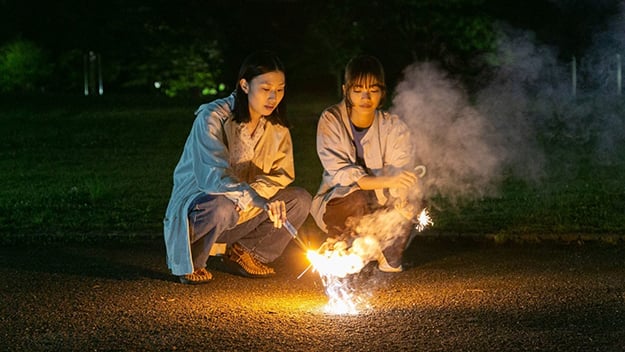Review: Remembering Every Night
This article appeared in the September 14, 2023 edition of The Film Comment Letter, our free weekly newsletter featuring original film criticism and writing. Sign up for the Letter here.

Remembering Every Night (Yui Kiyohara, 2022)
Tama New Town, the setting of Yui Kiyohara’s Remembering Every Night, might be better known to U.S. audiences from its appearance in two Studio Ghibli films: Pom Poko (1994) and Whisper of the Heart (1995). In the first of these, the town is a massive, tree-lined suburb that destroys the spiritually significant forests the film’s tanuki inhabit. Whisper of the Heart, however, contains none of this environmentalist ire, treating the fully built town as an idyllic backdrop for a serendipitous, whimsical romance. Kiyohara, who grew up in the area, seems to value both of these perspectives as essential and complementary. Whereas the Ghibli films played up the newness of the town to different ends, Remembering Every Night portrays it as a ruin in the making, a place whose undeniable charms belie a palimpsest of neglected and forgotten existences.
Over the course of a single day, we follow the interwoven, peripatetic paths of Tama residents Chizu (Kumi Hyodo), Sanae (Minami Ohba), and Natsu (Ai Mikami), three women at different stages of life. Unemployed, single, and entering middle age, Chizu struggles to reconnect with old friends who have moved on to new lives. Sanae, a gas meter inspector in her thirties, is the only source of companionship for the town’s seniors as she makes her rounds. (Suburbs like Tama New Town, which were planned as public housing in the 1960s, now face a severe demographic crisis due to policies that have pushed younger populations away into private housing, leaving elderly residents to fend for themselves in isolation.) Natsu, an undergrad at a nearby university, brings an exceptional vigor to the film: the first time we see her, she’s dancing alone in a park, seemingly without reserve or embarrassment.
But Natsu knows she’s being watched by a strange woman mimicking her moves. That woman happens to be Chizu, whose exaggerated copycat dance betrays her own anxieties over inhabiting a body labeled by society as worn-out and unproductive. It is one of many chance encounters between the women, who remain strangers to each other throughout the film. As if to affirm their vitality, they are constantly in motion, whether dancing, zipping down hills on bikes, or simply walking leisurely through the town’s beautiful but uncannily static scenery. It’s another element that evokes anime: stark contrasts between foreground movement and background stillness, between what inhabits the present and what is frozen in time. The effect can be disorienting: when Natsu and a friend visit a local museum and enter a room with Jomon artifacts unearthed during the town’s construction, a deceptively framed shot made me think for a moment that they were looking out of a window onto the surrounding landscape, when it was actually a vinyl graphic on the back of a large display case.
Parallel lives, spatial illusions, and conflicting temporalities also structure Kiyohara’s feature debut, Our House (2017), a sinister, multidimensional ghost story. But even though Remembering Every Night is a much cheerier outing, it is still foreboding in its implications. When Sanae finds a confused old man wandering around, loudspeakers blare out reports of a missing person matching his description. While the man’s antics lend an understated humor to this alarming situation, we are keenly aware that he has been effectively abandoned by his family, and is being treated as a piece of lost property. I couldn’t help but think of the notorious stabbings that took place in 2016 at a care home in neighboring Sagamihara, an extreme act of callousness rooted in the social reality that Kiyohara depicts. The absence of a shared, multigenerational community, reflected in the solitude the film’s characters experience, points to a broader rupture between history and the present generated by the town’s development itself.
If the film lacks an overarching narrative, that is by design. Perhaps it signals the loss of a kind of storytelling rooted in a reassuring historical continuity, and the creation of a new one in which time is disjointed and subjective. As night falls, each of the women confront something in their respective pasts that has been haunting them, prompting the film to make ambitious leaps across space and time, and enact their gestures of remembrance through montage. Even the women’s separate identities begin to blur as the light dims—at dusk, Natsu spies a group of people her age dancing in a park, finding herself in the same position as Chizu earlier in the film. The day weighs heavily on her, as does the memory of a departed loved one. Standing very still, she’s the one who looks old now, watching what feels almost like a danse macabre. And then she begins to dance, too.
Emerson Goo is a writer, film programmer, and landscape designer/planner from Honolulu, Hawaiʻi.







